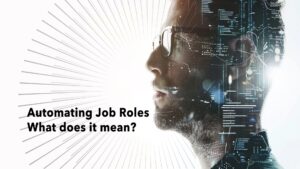Hyperautomation & Benefits in 2025
Hyperautomation is the next evolution of business automation, combining RPA, AI, analytics, and process mining to streamline operations end-to-end. Unlike traditional automation, it continuously optimizes workflows, ensuring efficiency, scalability, and agility. In 2025, businesses embracing hyperautomation will gain a competitive edge—driving innovation, resilience, and adaptability in an unpredictable market.
Key take-aways
- Holistic Automation Approach: Hyperautomation combines RPA, AI, IoT, and low-code tools for end-to-end process automation.
- Tangible ROI: Metrics like time saved per process and error-rate reductions help illustrate cost-benefit outcomes.
- Practical Use Cases: Industries like finance, healthcare, manufacturing, retail, and logistics have already adopted hyperautomation to streamline workflows.
- Roadmap for Implementation: Identify key processes, select tools, train teams, and continuously optimize to maximize benefits.
- Overcoming Challenges: Initial costs, talent gaps, and organizational resistance can be addressed with strategic planning and strong change management.
Technologies Behind Hyperautomation
Hyperautomation stands out because it harnesses a variety of cutting-edge technologies, aligning them under a single, unified strategy rather than deploying them in isolation. Here are the primary technological pillars that make hyperautomation possible:
RPA (Robotic Process Automation)
Robotic Process Automation excels at handling repetitive, rule-based tasks that require minimal decision-making. Examples include data entry, invoice processing, and report generation. RPA bots can replicate human interactions with software—like clicking, typing, or copying data between systems—24/7 without error or fatigue. According to a UiPath case study, many enterprises have cut operational costs by over 50% with large-scale RPA deployments.
AI (Artificial Intelligence) and ML (Machine Learning)
While RPA is highly effective for automating structured tasks, AI and ML bring intelligence into the equation. They can interpret unstructured data (like emails, images, or audio), make predictive analyses, and learn from historical patterns to adapt future decisions. This layer of intelligence transforms basic task automation into strategic decision-making assistance. For instance, an AI-driven hyperautomation system can examine complex financial data to detect anomalies or fraud in real time, alerting decision-makers far more quickly than manual oversight.
Low-Code and No-Code Platforms
Hyperautomation aims to make automation accessible to a broader range of employees, not just IT specialists. Low-code and no-code platforms enable “citizen developers” to design and deploy automated workflows with minimal coding knowledge. These platforms often feature drag-and-drop tools and intuitive dashboards for creating process maps. This democratization of automation accelerates adoption across an organization, reducing the burden on specialized tech teams.
IoT and Cloud Systems for Data Integration
In hyperautomation, data flow is the lifeblood. IoT devices collect real-time data—from factory sensors tracking machinery health to retail beacons monitoring customer foot traffic. Meanwhile, cloud-based systems store and process these massive data streams, making them readily accessible to RPA bots, AI models, and management dashboards. This synergy ensures that hyperautomation can scale effortlessly, as the infrastructure is flexible and can support growing data demands.
Real-World Use Cases of Hyperautomation
Hyperautomation is not confined to a single sector; it has the potential to disrupt nearly every industry. Below are some illustrative examples where these technologies converge to transform business processes:
Finance
Fraud Detection: By layering AI and RPA, finance companies can automatically flag unusual transactions in real time. AI models detect suspicious patterns based on massive historical data sets, while RPA bots instantly freeze or escalate accounts for further investigation.
Automated Compliance Reporting: Regulatory compliance is a significant concern for financial institutions. Hyperautomation tools pull data from various systems, compile them into compliance reports, and highlight discrepancies. This not only reduces manual effort but also minimizes costly regulatory fines.
Published Example: Automation Anywhere showcases how a global bank reduced its fraud detection time by over 90% through an integrated RPA-AI solution.
Healthcare
Patient Data Management: AI-driven automation assists in streamlining patient admissions, billing, and discharge processes. This frees healthcare professionals to focus more on patient care.
Diagnostics: Machine learning algorithms can evaluate medical imagery—like X-rays or MRIs—and highlight anomalies for further review. RPA can automatically add these findings to patient records, ensuring consistency and reducing human oversight errors.
Published Example: According to SAP’s Process Automation insights, several hospitals are already using hyperautomation for patient triage, drastically cutting down waiting times.
Manufacturing
Predictive Maintenance: Hyperautomation integrates IoT sensor data with AI to anticipate equipment failures before they happen. RPA bots then automatically schedule maintenance checks, order parts, or alert technicians.
Smart Factory Operations: Advanced robotics and automation systems collaborate to manage production lines autonomously. AI-driven systems optimize workflows in real time, allocating resources where they are needed most.
Real-World Example: A leading automobile manufacturer reported a 30% reduction in downtime after employing IoT-based predictive maintenance and automated scheduling Source: McKinsey on Manufacturing’s Digital Future.
Retail
Inventory Management: AI algorithms predict sales trends and automate inventory restocking. RPA can reorder items when stock levels fall below a threshold, preventing both overstock and stockout scenarios.
Personalized Customer Experiences: By analyzing customer purchasing behaviors and online interactions, hyperautomation systems can recommend products in real time, boosting sales and customer satisfaction.
Published Example: A major e-commerce retailer used hyperautomation to cut inventory costs by 20% while enhancing product recommendation accuracy, as documented by Automation Anywhere.
Logistics
Optimized Supply Chain: Hyperautomation tools synchronize data from multiple sources—suppliers, shipping carriers, and end consumers—to offer a unified view of the entire supply chain. AI-driven insights can then spot inefficiencies or bottlenecks and trigger automated interventions.
Delivery Tracking: RPA bots update shipping statuses in real time, automatically emailing customers about location and estimated delivery times. This transparency fosters trust and improves customer experience.
Published Example: UiPath highlights a freight company that reduced shipment delays by 35% through real-time data analytics and automated dispatch scheduling.
Calculating the ROI of Hyperautomation
One of the biggest questions businesses ask is, “How do we quantify the benefits?” Unlike traditional automation projects that focus solely on cost reduction, hyperautomation delivers multifaceted value—from reduced errors to faster innovation cycles. Here’s how organizations can measure ROI:
1. Time Saved per Process: Compare the time taken for tasks before and after automation. This metric directly translates into resource savings and improved employee productivity.
2. Reduction in Error Rates: Manual tasks are prone to errors. Tracking error rates over time can offer concrete evidence of hyperautomation’s quality improvements.
3. Cost of Technology vs. Manual Labor: Assess the initial technology investment—licensing fees, infrastructure costs—against ongoing labor expenses. Often, the break-even point can be reached in months rather than years.
4. Long-Term Scalability and Adaptability: While short-term gains are essential, hyperautomation also provides future-proofing. As businesses grow or pivot, the same infrastructure can be adapted with minimal additional cost.
By monitoring these metrics, stakeholders can determine if they are achieving a positive return on investment—or identify bottlenecks that require immediate attention.
Step-by-Step Guide to Implement Hyperautomation
For organizations looking to harness the power of hyperautomation, a structured rollout plan is crucial. Below is a detailed roadmap:
1. Identify High-Impact Processes for Automation
Begin with a thorough audit of your current workflows. Pinpoint the processes that are repetitive, prone to human error, or time-consuming—like invoice processing or claims management. Focus on tasks with clear value propositions to garner early wins and stakeholder buy-in.
2. Select Appropriate Tools and Vendors
With so many tools on the market—RPA platforms like UiPath or Automation Anywhere, AI services like TensorFlow or Azure AI, and IoT suites from vendors such as AWS or Microsoft Azure—choose solutions that align with your objectives. Investigate how these tools integrate, as seamless data flow is critical for hyperautomation.
3. Train Employees on the New Systems
Even the most advanced automation tools need human oversight, especially during the deployment phase. Provide robust training programs and tutorials to help employees understand the system’s capabilities. Low-code or no-code platforms are particularly beneficial for empowering non-technical staff.
4. Continuously Monitor and Optimize Workflows
Automation is not a “set it and forget it” endeavor. Use real-time analytics to track process performance, pinpoint glitches, and discover new opportunities for improvement. AI models also need periodic retraining to adapt to evolving data patterns.
Hyperautomation vs. Traditional Automation
Scope and Complexity
Traditional Automation: Focuses on a narrow set of tasks, often limited to one department or function.
Hyperautomation: Aims to integrate multiple systems, data sources, and technologies across the entire organization.
Intelligence
Traditional Automation: Usually rule-based, lacking the adaptability to handle unstructured data or complex decision-making.
Hyperautomation: Incorporates AI and ML, enabling intelligent decision-making and ongoing process optimization.
Longevity
Traditional Automation: Once set up, it can quickly become outdated if business needs change.
Hyperautomation: Modular by design, allowing businesses to add or swap technologies as they evolve.
Challenges and Limitations of Hyperautomation
While hyperautomation offers a powerful vision, it is not without its hurdles. Understanding these challenges allows organizations to develop robust mitigation strategies:
1. High Upfront Investment Costs
Procuring AI, RPA, and IoT solutions simultaneously can be expensive, especially for smaller businesses. Solution: Start small with a pilot project, and expand once ROI is demonstrated.
2. Need for Skilled IT Professionals
Setting up and managing complex automation systems requires specialized talent. Solution: Invest in ongoing training or partner with consulting firms proficient in hyperautomation deployments.
3. Resistance to Change Within Organizations
Employees might fear job displacement or feel overwhelmed by new technologies. Solution: Encourage open communication, offer clear career growth paths, and demonstrate how hyperautomation frees employees for higher-value tasks.
4. Security and Compliance Risks
Integrating multiple systems under one umbrella increases cybersecurity vulnerabilities. Solution: Employ robust security protocols, including encryption and multi-factor authentication, and ensure compliance with all relevant regulations.
The Future of Hyperautomation
Looking ahead to 2025 and beyond, the hyperautomation trend shows no signs of slowing down. In fact, its scope is likely to widen as new technologies enter the mainstream:
Greater Adoption of AI-Driven Decision-Making: As AI algorithms become more sophisticated, hyperautomation will shift from automating manual tasks to guiding strategic decisions across enterprises.
Integration with Blockchain for Secure Automation: Blockchain can ensure immutable and transparent records, making automated transactions more secure, especially in finance and supply chain scenarios.
Expansion into Smaller Businesses as Costs Decrease: The technology that once seemed exclusive to large enterprises will become more affordable. Cloud-based subscription models will further democratize access.
Expect hyperautomation to evolve from a competitive advantage to an operational necessity—those who fail to adopt will risk being outpaced by more agile competitors.
In Summary
Hyperautomation revolutionizes how organizations operate by integrating RPA, AI, low-code platforms, and IoT into a cohesive strategy. It offers tangible benefits like faster processes, fewer errors, and better scalability—all while empowering teams to focus on innovation rather than repetitive tasks. By carefully selecting the right technologies, training employees, and methodically measuring ROI, businesses can unlock new frontiers of efficiency and creativity.
FAQ
What is the difference between automation and hyperautomation?
Automation focuses on streamlining specific tasks, like scheduling email reminders or generating invoices. While it improves efficiency, it typically handles predefined and isolated processes.
Hyperautomation, on the other hand, integrates multiple technologies—such as RPA, AI, and ML—to automate complex workflows across an organization. For example, a consulting firm could automate the process of client data collection, analyze patterns using AI to provide strategic recommendations, and use RPA to generate client-ready reports. This creates a smarter, scalable, and more efficient operation.
How does Turbotic AI support hyperautomation?
Turbotic AI can help companies get started and scale their hyperautomation initiatives by analysing and structure unstructured data to create business cases, discovery reports and even prepare design and solution documents.
What are the three types of RPA?
1. Attended RPA: Works alongside consultants, assisting in tasks like retrieving data from multiple systems during client meetings or creating real-time dashboards for presentations.
2. Unattended RPA: Operates autonomously to handle tasks like data validation, report generation, and financial analysis overnight, ensuring deliverables are ready for client reviews.
3. Hybrid RPA: Combines attended and unattended capabilities. For example, consultants might use an attended bot to extract insights during a workshop while an unattended bot manages follow-up tasks like compiling findings into structured reports.
What industries benefit most from hyperautomation?
Consulting firms working across multiple industries can leverage hyperautomation to add value for their clients:
- Healthcare: Automating patient data analysis and compliance processes to improve client recommendations.
- Finance: Enhancing risk assessments, automating regulatory reporting, and streamlining portfolio management workflows.
- Manufacturing: Using IoT and process mining to identify inefficiencies in production and recommending automation strategies.
- Retail: Providing AI-driven customer insights and inventory optimization plans.
- Logistics: Analyzing supply chain inefficiencies and implementing automated solutions for tracking and delivery optimization.
How can consulting firms adopt hyperautomation?
Consulting firms can implement hyperautomation to enhance client projects and internal processes:
- Step 1: Identify high-value, repetitive tasks like data aggregation, initial analysis, or report generation. This can be done using Turbotic AI assistant.
- Step 2: Use platforms like Turbotic or similar tools to integrate automation into their workflow.
- Step 3: Train consultants to work with automation technologies, enabling them to combine technical insights with strategic advisory.
For instance, a consulting team tasked with analyzing a multinational corporation’s supply chain could automate data extraction from ERP systems, use AI to identify inefficiencies, and employ RPA to generate scenario-based solutions for the client.
What is the future of hyperautomation in consulting?
The future of hyperautomation in consulting is focused on:
- AI-Driven Insights: Consultants will use AI to generate actionable strategies in real-time, reducing the time spent on data preparation.
- End-to-End Project Automation: Firms will automate entire workflows, from data collection and analysis to client presentation and follow-up.
- Scalability: Automation will allow consulting firms to handle larger projects and clients without a proportional increase in resources.
- Customized Solutions: With hyperautomation, consultants can deliver highly tailored recommendations by leveraging AI and process mining to address client-specific needs.
Get Started with Hyperautomation Today
The future of business belongs to those who embrace hyperautomation. Turbotic AI makes it easier than ever to get started. With powerful tools for process discovery, automation design, and AI-driven insights, you can accelerate your hyperautomation journey and maximize ROI.
Sign up for Turbotic AI for free today and take the first step toward a smarter, more efficient automation.





